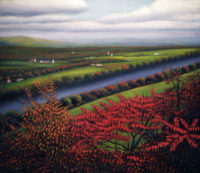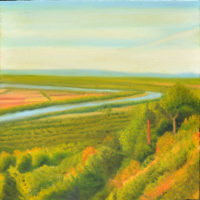: Randall Deihl
Randall Deihl is one of the valley’s most acclaimed artists and perhaps the most prominent figure in what has become nationally known as the Northampton Realist School. He was born in 1946 in Saginaw, Michigan. He studied at the Detroit Society of Arts and Crafts and at the California College of Arts and Crafts in Oakland California. He moved to New York City in 1969 where he made his living as a commercial artist doing detailed pencil drawings. He did political drawings for the New York Times op-ed page as well as magazines and book-jackets. He had his first one-man exhibition in 1971. In 1977 he moved to the Pioneer Valley, living in South Deerfield and then Northampton Center. Here he became a student of famed Realist painter, Gregory Gillespie and gained acclaim as part of a group known as the Valley Realists. Now in his mid-fifties, Randy has become one of the valleys most prominent and well known artists. Deihl’s paintings of Pioneer Valley landmarks hang in Museums throughout the country including the Art Institute of Chicago and the Museum of Fine Arts in Boston. His best known painting, Sweets, an interior of Northampton’s own Academy of Music, hangs in the permanent collection of the Metropolitan Museum of Art. He currently lives and paints in Western Massachusetts with his wife, painter Nan Hill.
16×40 in
10.5×12 in
SOLD
12×12 in
“To this day, I can spot unusual or out-of-the-way places where other people never notice them. My eye seeks them out and they become artistic opportunities for me. I travel with a camera, but when it comes to making my paintings, I will often change colors, skies, layouts and people. My philosophy is that I’m making a work of art, not a duplicate of a photograph. To some degree, I am consciously preserving places which history will no doubt forget, and I am doing my artistic part to resist corporate take-over. But I also have artistic motives, which supercede my archival interests. The sites I use are “vehicles” for something I always try to express; a sense of surrealism and that suspended moment one can become lost in. It may be a moment of tranquility or of anxiety, depending on the content of the artwork and the choices I’ve made, but I use place and time artistically as a crossroad to those feelings that transcend specifics.”
View more of Randy’s work here



